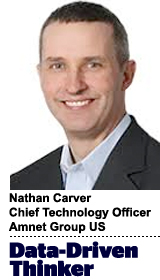 “Data-Driven Thinking” is written by members of the media community and contains fresh ideas on the digital revolution in media.
“Data-Driven Thinking” is written by members of the media community and contains fresh ideas on the digital revolution in media.
Today’s column is written by Nathan Carver, chief technology officer at Amnet Group US.
Investment in new product development is the single strongest predictor of a company’s future value. It’s for this reason that successful companies invest in R&D and build a culture based on calculated risks.
Most advertisers recognize the value of risk in their business. They know that without risks, growth slows, people become complacent and customers can become bored or dismissive. To reach new markets, people and possibilities, seasoned buyers regularly set aside test budgets for experimentation.
And given the complexity of the Lumascape diagrams, there is no shortage of ad tech companies clamoring for that experimentation. It’s no wonder the common refrain heard in this big-data era is, “I don’t need more data – I need to know what to do with the data I already have.”
Being able to take on risk and the budget and time required is even more onerous for small and mid-tier companies, even though they are the ones who might benefit the most.
What if the data you already collect informed your decisions before you buy instead of getting reporting after the fact?
A typical approach to risk is to recognize the need for change, analyze the opportunity and cost of failure, prepare for mistakes and take a leap of faith. Identifying success or failure happens later in summary reports.
Although this is a common approach and better than no plan at all, I would hesitate to call it a calculated risk. It is more like a framework to hone your instincts and business savvy.
For financial investors, risk is about the odds of losing money. Over time, their industry has evolved from historical analysis to statistical and mathematical modeling such as variance-covariance and Monte Carlo simulation. Using data and analytics transformed the market and richly rewarded those able to adopt the new approaches.
The key element of these approaches is using data analytics to calculate possible outcomes before you invest. That sounds more like a calculated risk.
And to be clear, risk is different from uncertainty. Uncertainty is comprised of all the unknowable events and resists quantification. No one can know the future. But risk is by definition quantifiable and manageable. It can be described by statistics and probabilities. Knowing the difference is the key to succeeding in calculated risks.
Let’s consider the basic stalwart of measurement: lift analysis. The process of spending budget on public service announcements to differentiate between an exposed and unexposed audience is so common that many don’t question the approach. That extra spend is simply the cost of scientific analysis. Never mind the time required to collect the audience data.
But is this approach really managing risk? Can the insights predict repeated impact? No, this approach is a response to uncertainty. It spends time and budget without providing any insight except on what has already happened.
What would a calculated risk look like?
In today’s big-data environment, it is possible to use techniques such as pathway analysis to determine the effectiveness of segments or tactics without waiting for a lift test at the next QBR. These statistical approaches are not unlike a financial investor’s analysis of risk. They quantify probabilities before you spend a dime.
Follow Amnet Group (@amnetgroup) and AdExchanger (@adexchanger) on Twitter.
This post was syndicated from Ad Exchanger.


More Stories
Call for entries campaign for Gerety 2025
Friday, Feb. 21 Evening Cable News Ratings: Kaitlan Collins Is 1st in the Demo for CNN
Get closer to the action with Go Media’s new Game Frame